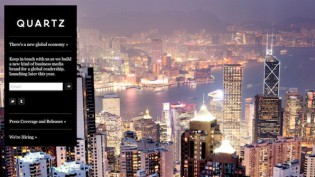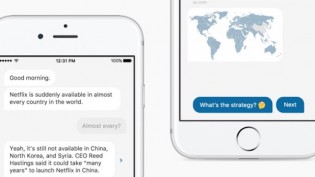Business news site Quartz began life 10 years ago as an ambitious news site targeting the “global business elite.” It saw its competition as the Financial Times, The Wall Street Journal, and The Economist. Its ads, glossy as a magazine’s, came from the likes of Cathay Pacific, Rolex, Credit Suisse, Ralph Lauren, and Boeing. By 2017, it had turned a profit for the first time and planned on 270 staffers worldwide.
In recent years, with revenue cratering and employees laid off, it became clearer that Quartz had not achieved its early promise. (What’s the last Quartz story you read?) Still, it was a shock to many to see it sold to G/O Media, the private equity firm–owned digital media conglomerate that relies on cheap, programmatic ads and which has gotten perhaps the most attention in its corporate life for wrecking Deadspin.
Reactions to the news on Thursday included: “An actual gasp,” “I audibly gasped,” “I audibly gasped at this news,” “oh boy,” “hoping for the best for my colleagues,” “ugh. what a mess,” “bleak,” “lollololololololol,” “uhhhhhhhh,” “whoa,” “this is going to be messy, “wow wow wow,” “would not have predicted this,” “bummer.”
“After taking Quartz private in 2020, we had sought to raise money and remain on our own,” Zach Seward, the company’s cofounder, who will become its editor-in-chief under G/O Media, wrote in a memo to staff on Thursday. “Selling was not the plan, but it became the very best path for Quartz, and for all of you, when we started talking to G/O earlier this year.” He promised, “There are no layoffs connected to the sale, nor planned once we integrate,” and said employees “will be eligible for deal bonuses from the proceeds of the sale, totaling more than $1 million.” Quartz currently has “around 100” employees, per its PR person.
Katherine Bell, the company’s current editor-in-chief, is leaving the company “to try something new. We remain business partners, and struck this deal with G/O together. She supports it,” Seward wrote.
The site, which got rid of its paywall two weeks ago, will continue its premium paid newsletters, which will also be G/O Media’s first subscription products, Seward (one of Nieman Lab’s earliest employees) told me.As Seward also noted in his memo, “This is the third time Quartz has been sold.” The site launched in 2012 as Atlantic Media’s business site, a mobile-first property offering news for a young, elite international audience.
In 2018, it was bought by Uzabase in Japan for a reported $86 million. In 2020, Quartz laid off 80 staffers (out of a staff of about 180) and closed international offices. Later that year, Seward bought the company back from Uzabase.
In the pre-Uzabase era — say, 2012 to 2016 — Quartz was quirky, inventive, and on the path to profitability. It launched as a free site, supported not by traditional display advertising but via sponsorships from Boeing, Credit Suisse, Chevron, and Cadillac. “We’re not the first to do sponsored content, but what’s interesting is the fact that we’re building it into the foundation,” Atlantic Media president Justin Smith said at the time.
“There are few more compelling digital journalism stories than the growth of Quartz,” our Joshua Benton wrote in 2015. “Though it was born with the advantage of a highly desirable target audience — the global business elite — it has still managed to do so much right: sharable content, visual distinction, global reach, smart advertising strategy, mobile-first design…all while maintaining high quality. It’s one of the few operations I recommend to the many people who ask me: Who’s doing it right?”
Quartz experimented early with chat apps and released its own data visualization tool, Atlas. The site surpassed The Economist in web traffic in 2013. It grew its annual revenue from $18.6 million in 2015 to $30 million in 2016, according to an Uzabase investor presentation, but by 2017, revenue had fallen back to $27.6 million — a decrease that Uzabase said was due to overreliance on advertising revenue.So Quartz put up a paywall and launched a $100/year membership in 2019. But revenue continued to collapse — to $12.3 million in 2020 and $11.1 million in 2021, sources told The New York Times. The sources also said that the site lost $6.9 million last year and, before the deal with G/O, had not been expected to break even until 2023. G/O Media CEO Jim Spanfeller said it will be profitable by the end of this year, the Times reported.
Two weeks ago, the paywall came down. “We had made that decision separately, before we even started talking to G/O,” Seward said, “but in fact it fits very well with G/O strategy.”
Seward told me that G/O Media’s “portfolio model, or conglomerate model, or stable-of-brands model, whatever you want to call it,” is a good fit for Quartz — as well as being, now, the model employed by “basically all of G/O’s competitors,” from Vox Media to Bustle Digital Group.
The acquisition will allow the newsroom to “focus on just doing the best journalism possible and reaching as many people as possible,” he said. “We won’t have to worry, day-to-day, about where our financing’s coming from, because we’re supported by a much larger organization.”
Additionally, he said, the programmatic advertising that G/O Media relies on — and that Quartz once eschewed — will be a strength. “G/O’s advertising business is complementary to ours,” he said.
The reaction to the sale on Twitter was considerably less enthusiastic. The promise that there will be no layoffs was met with disbelief, because G/O Media has made that claim before, only to go on to lay people off.
Still, Seward stressed in his memo to staff that G/O’s offer seemed like the company’s best option. When he and Bell considered other offers “from individual investors, funds, and other media companies…too often their visions for our future began with slashing jobs.” When he spoke to Spanfeller, “it wasn’t hard to get commitments to no layoffs and editorial independence.” And, he wrote, “G/O was able to put up enough cash in this deal for Quartz staff to get a cut, which wouldn’t have been possible in any other scenario.”
As for the criticism of the deal, well: “I would say, everyone should just keep reading and judge based on what we have produced and will produce in the future,” Seward told me.
What jumps out to me about the Quartz news:
Lost $6.9 million last year, drops paywall, & will be profitable by the end of the year?
The plan is to jam it full of programmatic ads.
A far cry from the original promise when it was part of The Atlantic.https://t.co/Svz9o5zZxD pic.twitter.com/Nya6brD4qn
— Sean Griffey (@seangriffey) April 28, 2022
America's #1 pastime isn't baseball. It's lying about how mindless consolidation doesn't result in layoffs. https://t.co/4zFHmP6jz4 pic.twitter.com/bJK0yIEu7b
— Karl Bode (@KarlBode) April 28, 2022
A site that looked great with no ads has joined a network of blogs that are cluttered with obstructive and obnoxious ads which is not good!
— Sam Blum (@SammBlum) April 28, 2022
Honestly I think it's just polite to finish strangling the pets you have before you get new ones https://t.co/bHDowePRCP
— Anna Merlan (@annamerlan) April 28, 2022
Photo of the Quartz newsroom in 2015 by Mia Mabanta.
"sold" - Google News
April 29, 2022 at 05:46PM
https://ift.tt/tlbViPO
“An audible gasp”: Quartz, once a high-flying startup, has sold to G/O Media - Nieman Journalism Lab at Harvard
"sold" - Google News
https://ift.tt/Br1Jm4t
https://ift.tt/tJjXFhl
Bagikan Berita Ini

















0 Response to "“An audible gasp”: Quartz, once a high-flying startup, has sold to G/O Media - Nieman Journalism Lab at Harvard"
Post a Comment